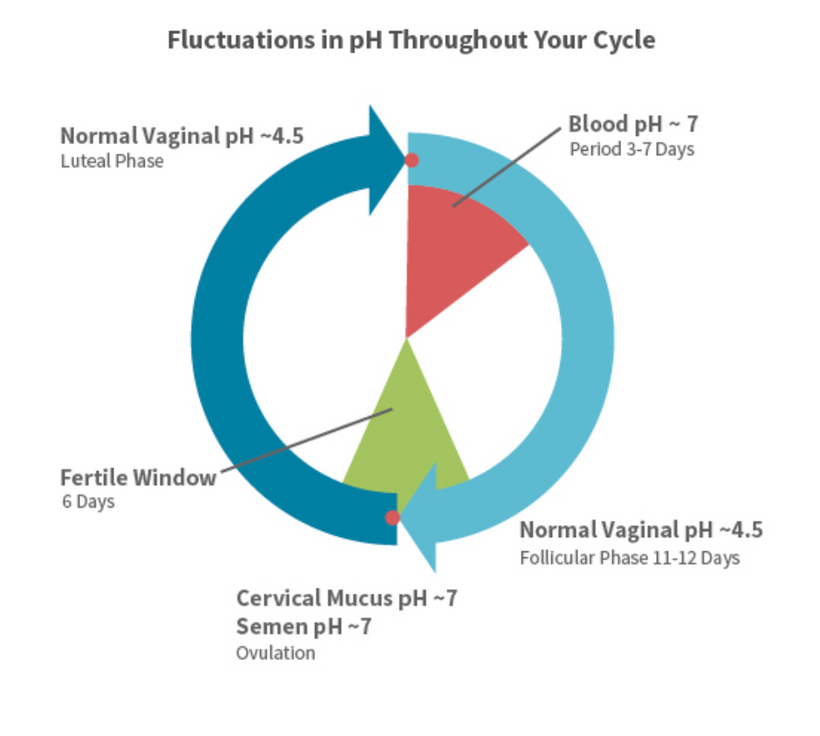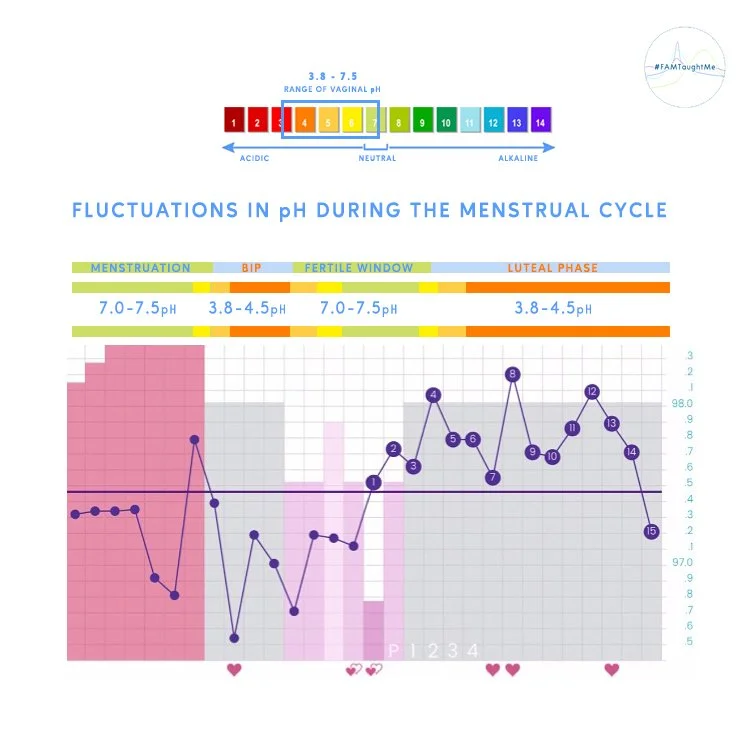A Guide to Vaginal pH
Our reproductive system is built to create and sustain varying pH levels throughout the cycle.
We do not have "a vaginal pH" -- we have a cycling of vaginal pH.
The changing pH of the vagina is determined by the normal fluctuation of hormones which release different kinds of cervical fluid. This fluid contains a microbiome - the vaginal ecosystem - and vaginal balance is characterized by beneficial lactobacillus-dominated microbiota. These microbes excrete a high concentration of lactic acid produced by the lactobacilli, and this acidifies the vagina, protecting it from harm. [1]
Menstruation: NEUTRAL ~ 7.0 pH - 7.5 pH
During menstruation, the vaginal ecosystem pH is more neutral than usual at around ~7 pH
The cervix is open & releases menstrual blood. Blood has a pH of 7.4 which contributes to this temporary state of neutral vaginal pH.
Follicular Phase before the Fertile Window (Basic Infertile Pattern): ACIDIC ~ 3.8 pH- 4.5 pH
At the conclusion of menstruation, the vagina returns to its naturally acidic state at around 4.5 pH.
The cervix produces G type cervical mucus which has a high viscosity & forms an impenetrable mucus plug. These cells are part of the immune system, leukocytes & lymphocytes, which protect the reproductive system from infection. Because the healthy lactobacilli produce lactic acid, they are able to control the vaginal ecosystem, which prevents infection by fighting off harmful bacteria and yeast.
G mucus also closes the cervix so it prevents entry of sperm into the cervix entirely. The plug forms in the lowest part of the cervix as this is where the G crypts are found.
Fertile Window & Ovulation: NEUTRAL ~ 7.0 - 7.5 pH
Sperm need an alkaline environment to be able to survive more than a couple of hours and swim to fertilize the egg. The body releases fertile cervical mucus to match the pH of semen, ~7-8 pH, during ovulation. The rising estrogen levels during the follicular phase preceding ovulation cause large shifts in the quantity and pH of cervical mucus. This fertile quality cervical mucus nourishes sperm and forms pathways to transport the sperm through the cervix to meet the egg.
During the fertile window, more neutral types of fluid - L, S, and P type mucus - are produced.
L mucus - Medium viscosity, this fluid comes from the middle crypts in the length of the canal. The structure of this fluid attracted malformed sperm, or slow movers, and stopped them from continuing. This fluid can give a sticky sensation at the vulva
S mucus - Low viscosity, slippery fluid, it comes from the upper crypts and can move rapidly along the vaginal canal, reaching the S crypts (the top) of the cervix in 3-10 minutes. It provides both nourishment and channels for sperm transport, and this produces a wet, lubricative sensation at the vulva, or a wet circle in your underwear.
P mucus - Produced at the upper most crypts of the cervix, nicknamed P for Peak. It mixes with an enzyme excreted from the isthmus which causes it to dissolve thicker mucus, including liquify the L mucus, releasing those locked up sperm, as well as dissolving the L & S mucus. This process causes an extremely lubricative sensation around the peak day.
Luteal Phase: ACIDIC ~ 3.8 pH - 4.5 pH
After ovulation concludes, estrogen has fallen & progesterone is surging, which causes a rapid decline in the production of fertile quality cervical fluid. The G crypts are stimulated again, forming the mucus plug which will close the cervix for the rest of the menstrual cycle. The vagina returns to a balance of ~3.8-4.5 pH for the remainder of the cycle.
Let's take a look at all of this in a menstrual chart
When you're healthy, your vaginal microbiome stays balanced through this cycling of cervical fluid & cycling of pH.
Imbalance in Vaginal pH
When the vagina becomes dominated by harmful bacteria, they fight to reduce the number of lactobacilli in the vagina. When these beneficial lactobacilli microbes cannot make lactic acid, this will cause the vaginal pH to lose acidity & remain in a more neutral range. In turn, this creates an environment where even more of the anaerobic bacteria can grow, exacerbating a cycle of chronic vaginal infections.
A pH that stops cycling & is instead regularly or constantly higher than ~4.7 is an indication that the vaginal microbiome is disturbed. This elevated pH will also be accompanied by some of these symptoms:
a foul or fishy smell
chunky white, gray, or green discharge
vaginal or vulva itching
What can cause vaginal microbiome imbalance
I often hear people say 'X Y Z throws off your pH' but what does it really mean?
A pH that is 'thrown off' is one that is in a constant state of neutral-alkaline instead of a healthy cycle between neutral and acidic. There are many different root causes to what may be upsetting the vaginal microbiome including the diet, hygiene, and lifestyle of the person.
Some key things to think about:
Infection. Yeast infections, trichomoniasis, aerobic vaginitis, and other conditions cause the vaginal microbiome to be off balance, causing elevated pH levels.
Estrogen Imbalance. Estrogen is the hormone primarily responsible for the changes in cervical fluid which have an effect on the vaginal microbiome & pH level. If you have a deeper underlying issue with your cycling of estrogen, this can effect your vagina's ability to self regulate.
Antibiotics. These drugs don't discriminate which bacteria they kill, so unfortunately your lactobacilli will take a hit when you use antibiotics.
Douching. Douching wipes out the bacteria in the vagina and has ingredients which are neutral or alkaline. This destroys the microbial protection of lactobacilli while increasing the pH level of the vagina, and creating an environment for harmful bacteria to thrive in.
Absorbent menstrual products. Menstrual blood has a neutral pH of ~7, and when that blood is not allowed to exit, and is instead held in place in the vagina with absorbent products, it creates an environment for these harmful bacteria to live.
Semen in the vagina Semen is neutral to alkaline at around ~7.5 pH, which has the potential to impact the vaginal microbiome. There is an infection or a blockage if semen pH is outside the normal neutral range, which can further tax the vaginal microbiome. However -- I can say with great confidence, as someone who regularly has unprotected sex: If your vaginal microbiome is healthy, and your partner is healthy, you will not have microbiome disruption or a pH imbalance from sex alone.
Birth Control. Hormonal birth control shuts down ovulation & therefore you have halted your cycling of estrogen which controls your release of cervical fluid. When using hormonal contraceptives your vagina will maintain a more neutral to alkaline pH, putting you at greater risk of infection. Copper IUDs also increase the risk of BV.
I have chronic issues with my vaginal pH, what can I do?
Investigate the root cause. An elevated pH, or other symptoms of vaginal imbalance are signs from your body that you need to restore balance. You need to encourage beneficial bacteria to return & strengthen themselves so that they can fight off the harmful bacteria and keep them from causing discomfort. You cannot achieve this by wiping out more bacteria with antibiotics, or flushing out your vagina with a douching process.
Why your doctors BV test can be wrong
Sometimes after an annual gyno exam, you will receive a letter indicating that you tested positive for bacterial vaginosis. However, the clinical diagnosis of BV is a pH of ~4.7 or higher. What's interesting about this is that this criteria is still well within a normal range of vaginal pH as you go through your cycle. If you are anywhere in the first half of your cycle, especially if you are in the fertile window, you will test at a higher pH than 4.7 even though this is perfectly normal. If you receive this notice but have no symptoms of vaginal disruption, it is likely a false positive. This can also lead to healthy people using antibiotics unnecessarily, wiping out their healthy microbiome & setting themselves up for an infection later on.
Let's review:
There is no static pH balance
Our vaginal pH changes based on the hormones of our menstrual cycle
Menstruation & fertile quality cervical fluid have a neutral pH
Infertile quality cervical fluid has an acidic pH
Imbalanced pH comes from a weakened vaginal microbiome
There is an underlying cause as to why the microbiome is hindered
Antibiotics cannot restore balance because they kill beneficial bacteria
To heal the vaginal microbiome you must uncover & treat the root cause
Citations
[1] The role of lactic acid production by probiotic Lactobacillus species in vaginal health. https://www.sciencedirect.com/science/article/pii/S0923250817300839


